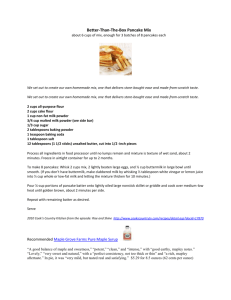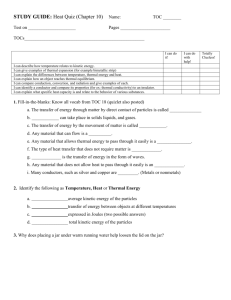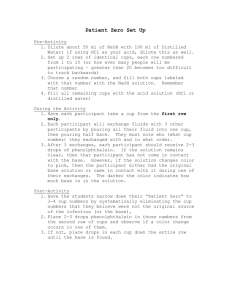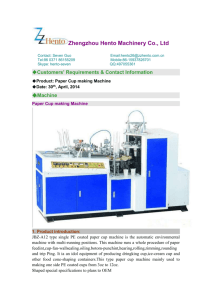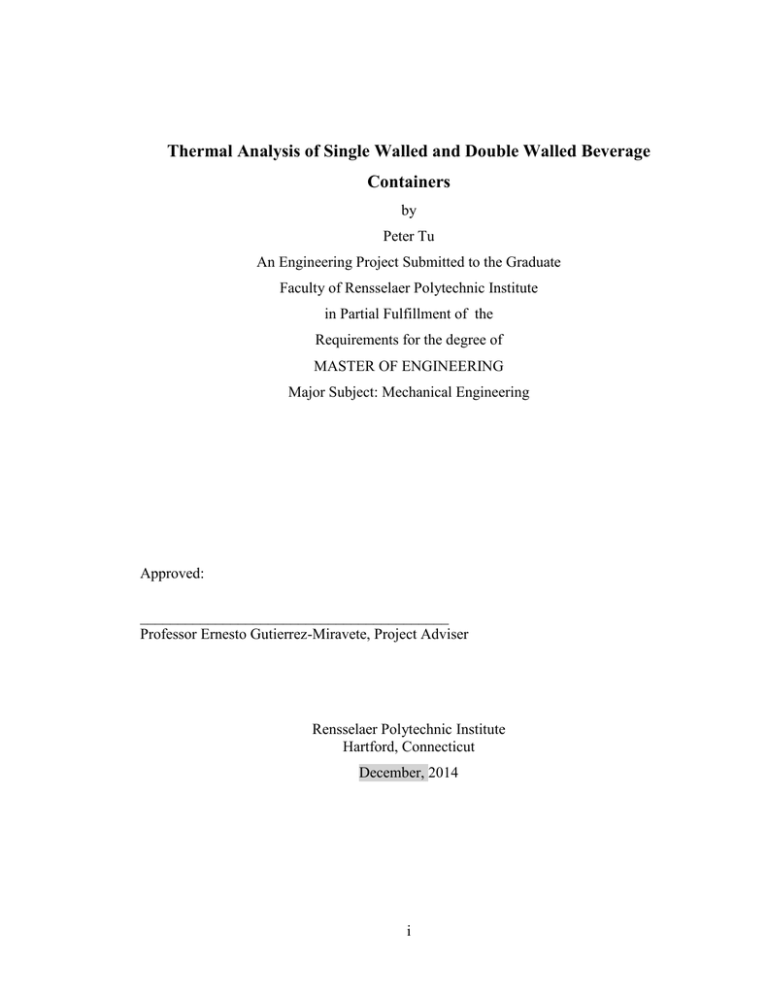
Thermal Analysis of Single Walled and Double Walled Beverage
Containers
by
Peter Tu
An Engineering Project Submitted to the Graduate
Faculty of Rensselaer Polytechnic Institute
in Partial Fulfillment of the
Requirements for the degree of
MASTER OF ENGINEERING
Major Subject: Mechanical Engineering
Approved:
_________________________________________
Professor Ernesto Gutierrez-Miravete, Project Adviser
Rensselaer Polytechnic Institute
Hartford, Connecticut
December, 2014
i
© Copyright 2014
by
Peter Tu
All Rights Reserved
ii
CONTENTS
LIST OF TABLES ............................................................................................................ iv
LIST OF FIGURES ........................................................................................................... v
SYMBOLS ....................................................................................................................... vi
ACKNOWLEDGMENT ................................................................................................. vii
ABSTRACT ................................................................................................................... viii
1. INTRODUCTION ......................................................................................................... 1
2. Theory & Methodology ................................................................................................. 3
2.1 Theory ................................................................................................................... 3
2.2 Methodology ......................................................................................................... 4
3. Results & Discussion ..................................................................................................... 6
4. Conclusion ..................................................................................................................... 7
5. References...................................................................................................................... 8
6. Appendices .................................................................................................................. 10
iii
LIST OF TABLES
iv
LIST OF FIGURES
Figure 1: Left - Single walled cup; Right - Double walled cup
Figure 2: Left – Plastic with straw, Center – Titanium with handle, Right – Ceramic
Figure 3: Schematic of the heat transfer process: 1. Thermal conduction through inner
wall, 2. Convection via trapped gas, 3. Thermal conduction through outer wall, 4.
Energy lost to environment
v
SYMBOLS
𝑄
𝑡
= heat transferred over time
𝑘 = thermal conductivity of the material
𝐴 = area of the interface
𝑇 = temperature
𝑑 = thickness of the interface
vi
ACKNOWLEDGMENT
I would like to acknowledge my family for their constant support and encouragement
throughout my career and studies. I would also like to acknowledge Professor Ernesto
Gutierrez-Miravete for his guidance and council as I conducted this final study.
vii
ABSTRACT
This project documents the analytical simulations that were performed along with the
collection of empirical data to confirm the validity of the claim that double walled
beverage cups keep hot liquids hotter for longer periods of time than single walled cups.
viii
1. INTRODUCTION
The traditional cup is typically a single walled container formed to hold liquids which
result can result in a rapid loss or gain of thermal energy depending on the geometry and
materials used. The need for cups that were less prone to rapid heat transfer has been
addressed by the invention of double walled cups.
The first double walled cup patent was issued on July 22, 1969 under number 3456860
to William L. Janninck. The original design featured plastic inner and outer walls
supported by circumferential and axial ribs that maintained structural integrity of the cup
while minimizing heat transfer from the inner to outer wall. Modern day manufacturers
now make double walled cups from a variety of materials, shapes, and sizes to
distinguish their products in terms of aesthetics and functionality.
Figure 1 depicts a single walled cup next to a double walled cup.
Figure 1: Left - Single walled cup; Right - Double walled cup
1
Figure 2 provides examples of products from various manufacturers to illustrate diverse
range of double walled cups.
Figure 2: Left – Plastic with straw, Center – Titanium with handle, Right – Ceramic
Based on similarity of double walled beverage cups to double paned windows, double
walled cups are expected to retain heat longer than single walled cups. The feature that
makes double walled cups effective at slowing the transfer of thermal energy is the layer
of trapped gas that modifies the path of transfer from only conduction to two instances of
conduction separated by convection.
This project characterizes analytically quantifies how much more effective a double
walled cup is when compared to a single walled cup.
2
2. Theory & Methodology
Double walled beverage cups are promoted as being able to keep hot drinks hot and cold
drinks cold for longer periods of time than single walled beverage cups. Much like
double pane windows, double walled mugs capture an insulating layer of air between
two layers of material and prevent thermal energy from being readily conducted through
to the other side.
2.1 Theory
The process of heat transfer can be simplified as follows:
1. The inner most wall of the window obtains thermal energy and transfers the energy to
towards the second wall via thermal conduction
2. The gas in between the two walls then transfer the thermal energy to the second wall
through convection
3. The energy is then conducted through the second wall
4. Lost to the environment via convection
Figure 3 is a schematic of this heat transfer process.
Figure 3: Schematic of the heat transfer process: 1. Thermal conduction through inner
wall, 2. Convection via trapped gas, 3. Thermal conduction through outer wall, 4.
Energy lost to environment
3
2.2 Methodology
Heat transfer is the process where thermal energy is exchanged between neighboring
systems in response to a temperature difference. This is in accordance to the
conservation of energy where the total energy of an isolated system remains constant and
the first law of thermodynamics where the change in internal energy of a system is equal
to the heat added to the system minus the work done by the system. There are three
modes of heat transfer; conduction, convection, and radiation.
Heat conduction is heat transfer across a medium without any motion of the material as a
whole. In a solid, the mechanism of conduction is the atomic activity in the form of
lattice vibration which contribution of the translational motion of electrons if the solid is
electrically-conducting. Heat conduction in a liquid or gas is due to the random motion
and interaction of the molecules. Common examples of conductive heat transfer are the
transfer of heat energy down the a metal rod when one end is higher than the other and
the transfer of heat energy from a stove element through a metal pan into the solid food
contained within. The rate of heat conduction can be expressed as follows:
𝑄 𝑘𝐴(𝑇ℎ𝑜𝑡 − 𝑇𝑐𝑜𝑙𝑑 )
=
𝑡
𝑑
Where:
𝑄
𝑡
= heat transferred over time
𝑘 = thermal conductivity of the material
𝐴 = area of the interface
𝑇 = temperature
𝑑 = thickness of the interface
Convective heat transfer occurs between systems by moving fluid past a wall at another
temperature. Convection can be forced or natural. For the purposes of this discussion and
project, only natural will be described. Natural convection occurs in accordance to the
4
Ideal Gas Law, where a liquid that increases in temperature also decreases in density and
rises, due to resulting internal buoyancy force, thereby causing circulating currents
which transport the heat energy.
Thermal radiation is a form of energy emitted by matter at a nonzero temperature and
can be considered to be the propagation of electromagnetic waves or particles. For the
purpose of this project, this form of heat transfer will be considered insignificant.
The following inputs and assumptions were used:
1. Initial temperature of the glass, air, and surrounding environment: 70 degrees
Fahrenheit or 21 degrees Celsius or 294.261 Kelvin
2. Initial temperature of the water: 212 degrees Fahrenheit or 100 degrees
Celsius or 373.15 Kelvin
3. Thermal conductivity of water @ 300 Kelvin: 0.609 𝑊 ∙ 𝑚−1 ∙ 𝐾 −1
4. Thermal conductivity of glass @ 300 Kelvin: 0.8 𝑊 ∙ 𝑚−1 ∙ 𝐾 −1
5. Natural convection heat transfer of a horizontal plate in air at 300 Kelvin:
11.26 𝑊 ∙ 𝑚−2 ∙ 𝐶 −1
6. Natural convection heat transfer of a vertical plate in air at 300 Kelvin: 7.03
𝑊 ∙ 𝑚−2 ∙ 𝐶 −1
5
3. Results & Discussion
The test specimen obtained for this project is the Kiran Tea Glass distributed exclusively
by Teavana. The cup is double walled, made from borosilicate glass, and holds 8 ounces
or 235 milliliters of liquid. The cup can be procured from any Teavana retail store or
from the company’s internet website. Figure xyz is a picture of the cup.
The reason for selecting this model of cup is due to its design being simple,
axisymmetric, and being made from a clear glass material. This simplifies not only the
analysis, but also eliminates complications in modeling changes in the heat energy
transport that could arise from geometries unique to certain areas of the cup.
A two-dimensional and three-dimensional model of the cup was created using NX, the
computer-aided design software package formerly known as NX Unigraphics. The
inputs used to model the cup were gathered using a scale, digital caliper, and radius
gages. All dimensions were gathering in the United States customary system units.
Figure xyz is a picture of the tools used to gather the dimensions of the cup being
analyzed.
Figure xyz is a picture of the two-dimensional and three dimensional models of the
cup created using NX.
COMSOL Multiphysics was used to create and solve the finite element analysis model.
The geometry created using NX was imported into COMSOL rather than using
COMSOL to create the model. The heat transfer module was used to perform the heat
transfer simulations.
Future interested parties would then be able to use this information to make informed
decisions as to whether these double walled products are worth the investment versus a
more traditional single walled. Thermal analysis models will be used to simulate and
predict the loss of thermal energy from a cup of hot water to the surrounding
environment.
6
4. Conclusions
As expected, the water in the double walled cup lost less thermal energy to the
surrounding environment than the single walled cup.
7
5. References
Janninck, W.L. (1969). U.S. Patent No. 3456860. Washington, DC: US Patent and
Trademark Office.
http://www.google.com/patents?id=qJ9ZAAAAEBAJ&printsec=abstract&zoom=4#v=o
nepage&q&f=false
The big one 2004. (2003). Catering Update, , 25-26,29-30. Retrieved from
http://search.proquest.com/docview/223152167?accountid=37764
Emily, B. Y. (2012, Mar 22). McDonald's testing paper cups for hot drinks. McClatchy Tribune Business News. Retrieved from
http://search.proquest.com/docview/929381998?accountid=37764
Young, C. (2011). Building a double wall. Building Design & Construction, Retrieved from
http://search.proquest.com/docview/1278116856?accountid=37764
Swiss inventor develops ornamental design for double wall cup. (2008, May 23). US Fed News
Service, Including US State News. Retrieved from
http://search.proquest.com/docview/472009520?accountid=37764
Donberg, D. (2003). Insulated cup a high-flying success. Paper, Film and Foil
Converter, 77(10), 14-14. Retrieved from
http://search.proquest.com/docview/211371519?accountid=37764
By, R. G. (1999, Feb 22). Starbucks plans to test a paper cup that insulates hands from hot
coffee. Wall Street Journal. Retrieved from
http://search.proquest.com/docview/398688536?accountid=37764
By, S. K. (1998, Mar 24). These people search for a cup that suits the coffee it holds --- the
current models can burn fingers, come unglued; mr. sadlier hawks `Insulair'. Wall Street
Journal. Retrieved from http://search.proquest.com/docview/398614978?accountid=37764
New Duo Shield[TM] double wall Cup. (2010, March). Food Trade
Review, 80, 177. Retrieved from http://go.galegroup.com.colelib-
8
prxy.ewp.rpi.edu/ps/i.do?id=GALE%7CA228269410&v=2.1&u=22507&it=r
&p=GPS&sw=w
"Skin-Care Packaging." Global Cosmetic Industry June 2000: 7. Vocations and Career Collection.
Web. 29 Mar. 2013.
Document URL
http://go.galegroup.com.colelibprxy.ewp.rpi.edu/ps/i.do?id=GALE%7CA63411694&v=2.1&u=22507&it=r&p=GPS&sw=w
"Mighty Jo travel mug -- 16 oz." Specialty Coffee Retailer June 2002: 54. Small Business
Collection. Web. 29 Mar. 2013.
Document URL
http://go.galegroup.com.colelibprxy.ewp.rpi.edu/ps/i.do?id=GALE%7CA87692510&v=2.1&u=22507&it=r&p=GPS&sw=w
Wolff, S. K. (1994). Double walled paper cup Retrieved from
http://search.proquest.com/docview/34737338?accountid=37764
Singaporean inventors develop double-walled cup. (2009, Sep 18). Indian Patents News.
Retrieved from http://search.proquest.com/docview/443239946?accountid=37764
Reflecting quality. (2006). Catering Update, , 30-30. Retrieved from
http://search.proquest.com/docview/223134574?accountid=37764
Kiran Tea Glasses at Teavana | Teavana. Retrieved from http://www.teavana.com/teaproducts/tea-cups-mugs/glass-tea-cups/p/kiran-tea-glasses-8oz
R. Nave. Heat Transfer. Retrieved from http://hyperphysics.phyastr.gsu.edu/hbase/thermo/heatra.html#c1
https://www.thermalfluidscentral.org/encyclopedia/index.php/Heat_and_Mass_Transfer
9
6. Appendices
10



